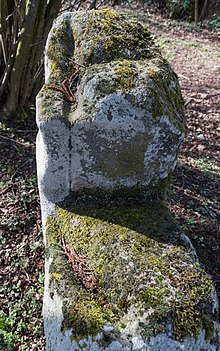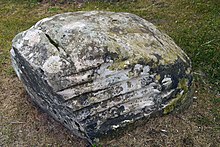Wetzrille
A Wetzrille , also sharpening mark , grinding groove or devil's claw , ( English grooved marking ; French polissoir ; Swedish Slipskåror der Sliprännor ) is a notch in stones created by human activity.
Occurrence
The notches can be found on erratic blocks and menhirs , rock walls and smaller stones, later also on secular and sacred buildings ( Egyptian temples). Also medieval buildings, stone crosses and Guide Stones have such traces. Over 3,600 grooves have been found on Gotland . They are single or parallel grooves that come in three forms:
- Boat
- spoon
- cut
There are also round and bowl-like, cup-shaped and concave notches. Stones exclusively cups are Schalensteine called.
Grinding grooves are also often found on the surrounds of wells and cisterns than in the past. Particularly pronounced on borders made of comparatively soft rock, such as B. sandstone. They were created by ropes on the buckets for scooping the water by deflecting them at the border.
Stone age
Occasionally the grooves appear on prehistoric monuments (menhirs). The boat-shaped and spoon-shaped ones may have been created by grinding stone axes. However, so far there is no evidence that Stone Age people created the grooves. Sometimes they appear in association with so-called pans , about four to six cm in size, flat, circular structures.
Bro, Sacrificial Spring, Gotland
Iron age
Source A few centimeters in size, mostly hat-shaped stones with a smooth surface, which are occasionally provided with circumferential, ground grooves, occur occasionally as grave goods in Iron Age urn cemeteries in Lower Saxony and Westphalia . They are more common on rabbits and dogs in Lower Saxony. They were initially interpreted as smooth stones or whetstones. Recently, it has been believed that it could have a cultic significance, given the monumental Rillensteine found in northern Lower Saxony and East Frisia . Regarding their time, it can be said that they were found in Westphalia several times with razors from the Iron Age.
Egypt
Source In Egypt there are such grooves. B. at the temples in Edfu, Luxor, Karnak and Aswan. The correspondence of types and shapes and their position (they are almost exclusively arranged vertically) in relation to the buildings are comparable in Egypt, Germany and Austria. The similarities between European and Egyptian grinding grooves suggest that the attachment is due to the same or a similar intention.
middle Ages
The younger grooves can be found in Europe on medieval cemetery walls, churches , (Old Lady Kirk on Sanday ) crosses or legal antiquities (courthouse, boundary stone, pillory) mostly outdoors and near the ground.
Explanations
Numerous explanations of the origin of the grooves and pans have been put forward, such as superstitious ideas, the whetting and sharpening of weapons and tools, or the extraction of stone powder for superstitious or folk medical purposes.
But there is also a mundane explanation: in the Middle Ages until the 19th century, before matches were introduced, fire was made with fire steel . It was used to strike sparks on the sandstone of the churches, which were ignited together with tinder . So the churchgoers lit their lanterns for the way home.


See also
- Pill
- Gantofta grinding grooves
- Grinding grooves from Foteviken
- Sliprännor for on Gotland occurring form
Examples
- Germany
- Marienkirche (Anklam)
- Blumenstein castle ruins in Schönau (Pfalz)
- Village church Schönhausen (Elbe) and village church Melkow ( Altmark )
- Cemetery wall in Dudweiler
- Church in Frankweiler
- Rillenstein from Marxen
- Rillenstein from Stedesdorf ( Wittmund district )
- Entrance portal of the parish church of the Assumption in Landsberg am Lech
- St. Aegidius Church in Berne
- St. Blasii Church in Quedlinburg , there also extensive occurrence of pans
- Freiburg Minster
- St. Michaels Church in Weidenberg
- Marienkirche in Büdingen
- St. Stephen's Church Schortens (Friesland)
- Sankt-Nikolai-Kirche (Luckau) , choir portal
- France (called Polissoir)
- Le Polissoir d'Haspelschiedt
- Polissoir de Grimery
- Polissoir of the Sept coups d'épée
- Le Polissoir de la Pierre aux dix doigts in Villemaur-sur-Vanne
- Church of St. Martin in Pfaffenheim in Alsace
- Gotland Sweden
- Bro ( Gotland ) at a source
- Bunge (Gotland), museum
- Hajdeby (Gotland) for outcrop
- Norrlanda Fornstuga (Gotland), museum
- Stenkyrka (Gotland) on monoliths
- Visne (Gotland) on the creek bank
-
Luxembourg
- Consdorf , on rock formations
-
Orkney
- the "ladies fingers" at the Old Lady Kirk on Sanday
- Czech Republic
- Romanesque outer pillars of the parish church of St. Jacob in Přelouč in Eastern Bohemia - the stock of grooves there is very extensive, as well as very extensive fields of cup-shaped notches.
See also
literature
- Joachim Jünemann: Grooves and pans on sacred monuments . In: Contributions to the history of pharmacy , 29. Jg., 1977, No. 4, pp. 24-31
- Joachim Jünemann: Gleanings on grooves and pans on sacred monuments . In: Contributions to the history of pharmacy , Vol. 31, 1980, No. 7, pp. 49-54
- Hans Cappel: "Wetzrillen" and other puzzling traces with special consideration of topics from the Saar-Palatinate. In: Saarpfalz. Sheets for history and folklore. No. 3, 2007, ISSN 0930-1011 , pp. 40-50.
- Karl Kohlstock: Sharpening marks on churches, gravestones, crosses and secular buildings in Thuringia. In: Journal of the Association for Thuringian History and Archeology. Vol. 38, 1932/33, ZDB -ID 200434-3 , pp. 269-277 ( online ).
- Udo Liessem: On the question of the grooves on sacred and secular buildings. In: Palatinate home. Vol. 29, No. 2, 1978, ISSN 0031-6679 , pp. 67-69.
- Willi Wegewitz : The Rillenstein from the forester's lodge Hollenbeck Kreis Stade. In: Stader Yearbook 1982 (= Stader Archive, NF 72). ISSN 0930-8946 , pp. 7-23.
- Rudolf Wilms: Wetzrillen on churches in the Zweibrücker area. In: Palatinate home. Vol. 28, No. 3, 1977, pp. 81-86.
Web links
- Description at www.suehnekreuz.de
- Peter Schels (1936–2015): Scraping marks on stone (grooves and pans) , as of November 22, 2018
- Grooves on Gotland
- Pfaffenheim church with grooves







